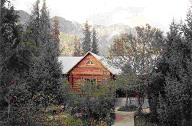Enilchek Mountain River
Rivers and lakes of Kyrgyzstan

In the Northeastern corner of Kyrgyzstan, two ridges of the Tian Shan converge and several peaks rise to over 6,000m. The Enilchek glacier snakes down from the clouds, nestling at the foot of Khan Tengri ("Prince of Spirits" or "Rider of the Sky" - 6,995m) on the borders with Kazakhstan in the North; and Peak Pobeda (Victory Peak, 7,439m - the second highest mountain in the former Soviet Union) on the border with China in the South. Stretching for 60 kilometers and covering an area of over 583 square kilomenters with ice, some of it as much as 540 meters thick - this glacier is one of the most famous in the world.
Sandwiched between the Northern and Southern branches of the glacier lies the mysterious Merzbacher lake, which forms every summer and sometimes in August bursts through its icy banks, its waters flowing into the Enchilek river. Actually, only part of the lake drains - the lake, which is 6 kilometers long and one kilometer wide, is in fact divided into two by a bridge of ice, and whilst the lower half empties regularly, the upper part is always full of water. Also, the lakes empty twice a year - once in the summer and once in the winter - but most people only know about the August event.
In 1903 the German geographer and mountaineer, Gottfried Merzbacher, first discovered the lake while leading an expedition into the Tian Shan mountains aiming to reach the summit of Khan Tengri. Forced back by the ice, from their originally intended route through the Byankol Pass and along the Semyenov and Mushketov glaciers, they attempted a different approach - along the Enilchek glacier. Once again they failed, but they had shown that Khan Tengri was in fact on a ridge and not in the center of that particular knot of the Tian Shan mountains as had been thought. The expedition will be better remembered, however, for the discover of the mysterious lake that now bears Merzbacher's name.
The expedition came across a clear lake, trapped between the two branches of the glacier, with the surface studded by floating icebergs. While the group was still in the vicinity - the lake suddenly drained. Another group of explorers, some 28 years later, experienced the same event. To their astonishment, the lake emptied before their very eyes, leaving huge blocks of ice stranded on the now dry lake bed. Their graphic accounts tells of how the water gushed from crevasses in the ice in various locations, accompanied by a great roar which frightened the horses, and how the end of the glacier seemed to threaten to break away and tumble downstream destroying everything in its way. Some of the party returned the next year - only to find the lake full once more.
Although this may be the most famous of the "vanishing lakes" - there are other similar occurrences around the world: in Iceland, Switzerland and Greenland - but each one is unique and only Merzbacher seems to be so regular in its timing. There are several theories about what is happening - some scientists suggest that the water level reaches a critical level so that the potion of the glacier that dams the lake begins to float - allowing the water to drain away beneath it. Another theory suggests that the pressure of the water actually causes deformations in the ice dam - that opens cracks which allow the water to escape. Yet a third theory links the drainage of the lake with a canyon-like feature in the Southern glacier, (known as "The Crack"). It is thought that when the Crack fills with water, this then drains away through tunnels under the ice - creating a suction effect which draws water out of the lake. Unfortunately, no one really knows exactly why the lakes drain as they do.
There are several trekking routes in the area, but as it is part of the border zone special permits are required. Several local firms can organize adventure trps to the region, including helicopter flights, and can arrange for accommodation at the Yak Farm at EchkiliTash. In the lower valley in a spectacular setting is the Khan Tengri camp, an ideal base for acclimatization and exploring the surrounding area.
